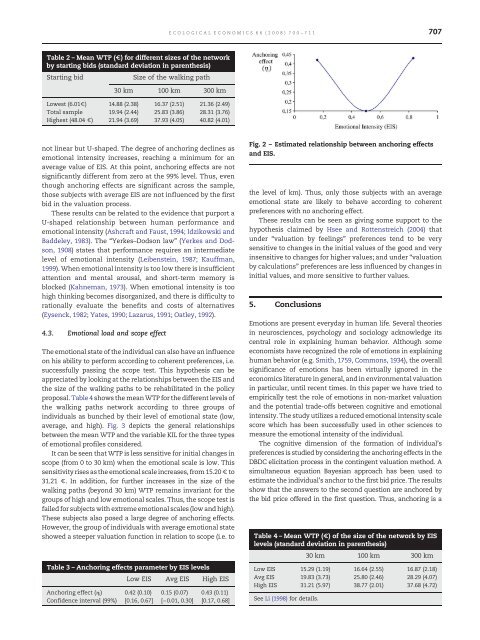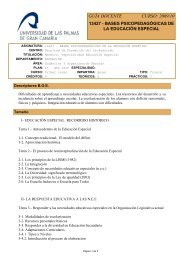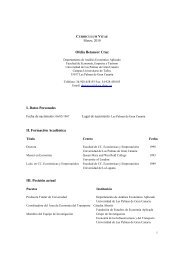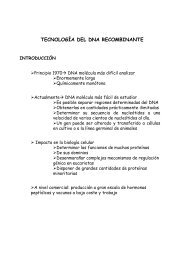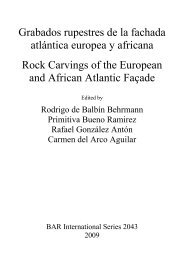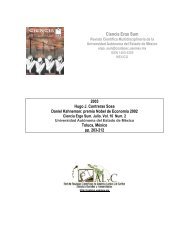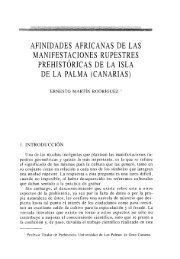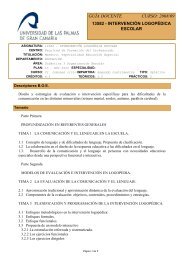Do emotions matter? Coherent preferences under anchoring and ...
Do emotions matter? Coherent preferences under anchoring and ...
Do emotions matter? Coherent preferences under anchoring and ...
You also want an ePaper? Increase the reach of your titles
YUMPU automatically turns print PDFs into web optimized ePapers that Google loves.
ECOLOGICAL ECONOMICS 66 (2008) 700– 711707Table 2 – Mean WTP (€) for different sizes of the networkby starting bids (st<strong>and</strong>ard deviation in parenthesis)Starting bidSize of the walking path30 km 100 km 300 kmLowest (6.01€) 14.88 (2.38) 16.37 (2.51) 21.36 (2.49)Total sample 19.94 (2.44) 25.83 (3.86) 28.31 (3.76)Highest (48.04 €) 21.94 (3.69) 37.93 (4.05) 40.82 (4.01)not linear but U-shaped. The degree of <strong>anchoring</strong> declines asemotional intensity increases, reaching a minimum for anaverage value of EIS. At this point, <strong>anchoring</strong> effects are notsignificantly different from zero at the 99% level. Thus, eventhough <strong>anchoring</strong> effects are significant across the sample,those subjects with average EIS are not influenced by the firstbid in the valuation process.These results can be related to the evidence that purport aU-shaped relationship between human performance <strong>and</strong>emotional intensity (Ashcraft <strong>and</strong> Faust, 1994; Idzikowski <strong>and</strong>Baddeley, 1983). The “Yerkes–<strong>Do</strong>dson law” (Yerkes <strong>and</strong> <strong>Do</strong>dson,1908) states that performance requires an intermediatelevel of emotional intensity (Leibenstein, 1987; Kauffman,1999). When emotional intensity is too low there is insufficientattention <strong>and</strong> mental arousal, <strong>and</strong> short-term memory isblocked (Kahneman, 1973). When emotional intensity is toohigh thinking becomes disorganized, <strong>and</strong> there is difficulty torationally evaluate the benefits <strong>and</strong> costs of alternatives(Eysenck, 1982; Yates, 1990; Lazarus, 1991; Oatley, 1992).4.3. Emotional load <strong>and</strong> scope effectThe emotional state of the individual can also have an influenceon his ability to perform according to coherent <strong>preferences</strong>, i.e.successfully passing the scope test. This hypothesis can beappreciated by looking at the relationships between the EIS <strong>and</strong>the size of the walking paths to be rehabilitated in the policyproposal. Table 4 shows the mean WTP for the different levels ofthe walking paths network according to three groups ofindividuals as bunched by their level of emotional state (low,average, <strong>and</strong> high). Fig. 3 depicts the general relationshipsbetween the mean WTP <strong>and</strong> the variable KIL for the three typesof emotional profiles considered.It can be seen that WTP is less sensitive for initial changes inscope (from 0 to 30 km) when the emotional scale is low. Thissensitivity rises as the emotional scale increases, from 15.20 € to31.21 €. In addition, for further increases in the size of thewalking paths (beyond 30 km) WTP remains invariant for thegroups of high <strong>and</strong> low emotional scales. Thus, the scope test isfailed for subjects with extreme emotional scales (low <strong>and</strong> high).These subjects also posed a large degree of <strong>anchoring</strong> effects.However, the group of individuals with average emotional stateshowed a steeper valuation function in relation to scope (i.e. toTable 3 – Anchoring effects parameter by EIS levelsLow EIS Avg EIS High EISAnchoring effect (η i ) 0.42 (0.10) 0.15 (0.07) 0.43 (0.11)Confidence interval (99%) [0.16, 0.67] [−0.01, 0.30] [0.17, 0.68]Fig. 2 – Estimated relationship between <strong>anchoring</strong> effects<strong>and</strong> EIS.the level of km). Thus, only those subjects with an averageemotional state are likely to behave according to coherent<strong>preferences</strong> with no <strong>anchoring</strong> effect.These results can be seen as giving some support to thehypothesis claimed by Hsee <strong>and</strong> Rottenstreich (2004) that<strong>under</strong> “valuation by feelings” <strong>preferences</strong> tend to be verysensitive to changes in the initial values of the good <strong>and</strong> veryinsensitive to changes for higher values; <strong>and</strong> <strong>under</strong> “valuationby calculations” <strong>preferences</strong> are less influenced by changes ininitial values, <strong>and</strong> more sensitive to further values.5. ConclusionsEmotions are present everyday in human life. Several theoriesin neurosciences, psychology <strong>and</strong> sociology acknowledge itscentral role in explaining human behavior. Although someeconomists have recognized the role of <strong>emotions</strong> in explaininghuman behavior (e.g. Smith, 1759, Commons, 1934), the overallsignificance of <strong>emotions</strong> has been virtually ignored in theeconomics literature in general, <strong>and</strong> in environmental valuationin particular, until recent times. In this paper we have tried toempirically test the role of <strong>emotions</strong> in non-market valuation<strong>and</strong> the potential trade-offs between cognitive <strong>and</strong> emotionalintensity. The study utilizes a reduced emotional intensity scalescore which has been successfully used in other sciences tomeasure the emotional intensity of the individual.The cognitive dimension of the formation of individual's<strong>preferences</strong> is studied by considering the <strong>anchoring</strong> effects in theDBDC elicitation process in the contingent valuation method. Asimultaneous equation Bayesian approach has been used toestimate the individual's anchor to the first bid price. The resultsshow that the answers to the second question are anchored bythe bid price offered in the first question. Thus, <strong>anchoring</strong> is aTable 4 – Mean WTP (€) of the size of the network by EISlevels (st<strong>and</strong>ard deviation in parenthesis)30 km 100 km 300 kmLow EIS 15.29 (1.19) 16.64 (2.55) 16.87 (2.18)Avg EIS 19.83 (3.73) 25.80 (2.46) 28.29 (4.07)High EIS 31.21 (5.97) 38.77 (2.01) 37.68 (4.72)See Li (1998) for details.


